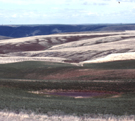Changes in Snowfall in the Southern Sierra Nevada of California Since 1916
John R. Christy and Justin J. Hnilo. 2010. Changes in Snowfall in the Southern Sierra Nevada of California Since 1916. Energy & Environment, Vol. 21, No. 3, 2010
Full text [here]
Selected excerpts:
Abstract
A time series (1916–2009) of annual snowfall totals for Huntington Lake (HL, elev. 2141 m) in the southern Sierra Nevada of California is reconstructed. A reconstruction is (a) necessary because HL data after 1972 are mostly missing and (b) possible because nearby stations reveal high correlations with HL, two above 0.90. The results show mean annual snowfall in HL is 624 cm with an insignificant trend of +0.5 cm (+0.08%) ±13.1 cm per decade. Similar positive but insignificant trends for spring snowfall were also calculated. Annual stream flow and precipitation trends for the region again were insignificantly positive for the same period. Snow-water-equivalent comparisons, measured on 1 Apr since 1930 at 26 sites and since 1950 at 45, show similar small, mostly positive, and insignificant trends. These results combined with published temperature time series, which also reveal no significant trends, form a consistent picture of no remarkable long-term changes in the snowfall of this area and elevation of the southern Sierra Nevada of California since the early 20th century.
Conclusion
With the available data from six mid-elevation stations in the Southern Sierra region of California we reconstructed annual snowfall totals for 36 missing years of the Huntington Lake record to complete the time series (1916–2009). The standard error of the missing years is calculated to be ±36 cm, or 6% of the 94-year annual mean of 624 cm in the most robust estimation method (though we utilized the average of six methods which reduces the standard error further.)
The results of both the annual and spring snowfall time series indicate no remarkable changes for the 1916–2009 period in the basins drained by the Merced, San Joaquin, Kings and Kaweah Rivers. In the six reconstructions the range of trend results varied only slightly from -0.3% to +0.6% per decade. With a consensus trend of only +0.5 cm (+0.08%) per decade ±13.1 cm per decade there is high confidence in the “no-significant-trend” result. The corroborating information on temperature trends (Christy et al. 2006), stream flow, precipitation and shorter period snow water equivalent trends presented here are consistent with “no-significant-trend” in So. Sierra snowfall near 2000m elevation since 1916.
The statistical properties of annual snowfall, and associated annual variables mentioned above, demonstrate the high level of variability in western precipitation. For example, calculating trends over short periods, such as in 25-year segments, produces a wide range of trends as low as -83.0 to +82.8 cm per decade with a median of +10.2 cm per decade and a most recent (1985–2009) value of +15.9 (+2.6%) cm per decade. This suggests that the impacts of interannual and interdecadal variations are to be considered of serious import in comparison with impacts of long-term trends which have been shown to be negligible in this region to this point. …
